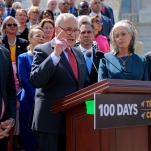School could be out forever for some in Tennessee if this district runs out of money
While teens across the United States reveled in their days off from school for Columbus Day, hundreds of students in Clay County, Tenn., had the day off for a completely different reason: a funding shortfall could mean school is out for good.
The school district oversees around 1,150 students across three schools, and a years-long budget crisis may finally be reaching a boiling point. The Clay County Board of Education, and its outspoken superintendent, Jerry Strong, have asked the Clay County Commission for an increased budget to keep the school financially in step with state and federal guidelines.
Tennessee has a system of revenue-sharing called the Basic Education Program which distributes more than $6 billion dollars across 144 school districts “that are required to share the cost based on local ability to raise revenues,” according to the Memphis Daily News.
But so far, the Clay County Commission, which oversees the local government, has rejected budget proposals, even after the CCBE cut some costs by laying off some employees and offering early retirement to veteran teachers and replacing them with younger, cheaper teachers (see statement below). Strong is not alone in thinking that if the County Commission’s actions are deemed acceptable, the process of funding state-run schools will “render local school boards to that of figurehead status in charge of an empty body.”
Strong said that enrollment has been stagnant in recent years, exacerbating the problem, and the school district is still paying off construction costs on Clay County High School after it was rebuilt in 2002.
According to NBC Nashville, problems for the county started three years ago as insufficient revenue from local property taxes fell behind new state and federal education guidelines, including the Affordable Care Act. The school board voted to close all three schools Oct. 8; the next day, two parents filed a lawsuit against the school district. By Oct. 12, a judge issued an injunction declaring that schools reopen Oct. 19 after a long-scheduled fall break. A Clay County official confirmed that schools did in fact re-open Monday.
Strong told me over the phone that even though a judge had ordered that schools re-open this week, that’s not the issue: “We don’t have much money in Clay County.”
-

-

-

-

-

-

-

-

-

-

-

-

-

-

-

-

-

-

-

-

-

-

-

-

-

-

-

-

-

-

-

-

-

-

-

-

-

-

-

-

-

-

-

-

-

-

-

-

-

-

-

-

-

-

-

-

-

-

-

-

-

-

-

-

-

-

-

-

-

-

-

-

-

-

-

-

-

-

-

-

-

-

-

-

-

-

-

-

-

-

-

-

-

-

-

-

-

-

-

-

-

-

-

-

-

-

-

-












































































































